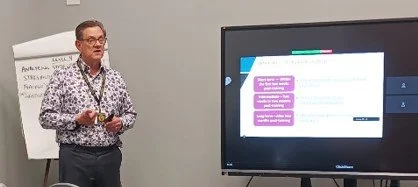The Cost of Guesswork in Learning & Development
/When Training Becomes the Default
Every year, organizations spend over $100 billion on training, yet most can’t prove it improves performance.
Sound familiar? A department requests a new course, leadership approves the budget, and the L&D team gets the brief: “Build the training.”
But no one has confirmed whether training is even the right solution.
The result?
Employees are stuck in sessions that don’t fix the problem.
Managers see no real change.
Executives wonder what they got for their investment.
The truth is simple: training only works when it solves the right problem.
Why Guesswork Costs So Much
When training starts without diagnosis, three things happen:
1. Time and money disappear.
Teams create learning that doesn’t move results. If the real issue is a process gap or unclear expectations, training won’t help.
2. Credibility takes a hit.
When leaders don’t see measurable improvement, L&D looks like a cost center instead of a performance partner.
3. Opportunities vanish.
Energy spent on the wrong solution delays the fixes that actually matter—better feedback, tools, or incentives.
Guesswork keeps everyone busy, but guesswork does not deliver results.
From Guesswork to Evidence
The Five Essential Questions Workshop from Ethnopraxis helps organizations break that cycle. It gives L&D teams and business leaders a shared way to decide when training is the correct answer—and when it isn’t.
You’ll learn how to:
Identify the real performance gap.
Decide whether learning will close the performance gap.
Design training that connects directly to measurable outcomes.
Track what actually changes on the job.
When L&D speaks the language of business—behavior, metrics, and results—training stops being a checkbox activity and becomes a competitive advantage.
The Five Essential Questions
Every successful program starts with these questions:
1. What behavior should change?
Define the specific actions that drive success.
2. How will we measure that change?
Choose metrics that matter—performance numbers, quality data, or customer results.
3. What business outcome will this improve?
Link the behavior to something leadership already values.
4. What evidence will prove success?
Plan evaluation from day one so you can show the impact later.
5. When will we measure results?
Follow up at 30, 60, and 90 days to confirm that learning turned into action.
These questions sound simple, but they align L&D with business priorities—and prevent wasted effort.
Why This Approach Works
The framework draws on decades of proven practice in learning design and performance improvement.
Think of it as a practical blend of what the field already knows works:
Design with intention – Plan before you build.
Focus on behavior – Identify what people must do differently.
Create real learning experiences – Make training authentic and applied.
Measure what matters – Track transfer of training and impact, not just attendance.
Keep measuring – Evaluate over time, not once.
You don’t need to memorize the research—the workshop turns these best practices into tools you can use immediately.
What It Means for L&D Professionals
If you’re in Learning & Development, this framework gives you confidence and credibility.
You’ll be able to:
Diagnose problems instead of taking every request at face value.
Design learning that targets real behaviors.
Show data that proves results.
It turns L&D from “order-taker” to trusted advisor.
What It Means for Leaders and Managers
If you lead teams or oversee budgets, this approach helps you make better decisions.
You’ll see which challenges require learning and which need a process, system, or leadership fix.
And you’ll have a clear line of sight between training investment and business performance.
When managers reinforce new behaviors, evaluate progress, and talk about results, learning sticks—and performance grows.
Closing the Credibility Gap
The future of learning isn’t about more content. It’s about measurable impact.
Organizations that diagnose first, design with intent, and evaluate over time build a culture of accountability and improvement.
Through the Five Essential Questions Framework, L&D professionals and leaders share a common language for results. Training becomes less about hours and courses—and more about outcomes that matter.
Bring the Workshop to Your Organization
Stop guessing. Start proving.
The Five Essential Questions Workshop equips your team to diagnose before they design, measure what matters, and demonstrate business impact.
Each workshop includes:
A four-hour interactive workshop (virtual or in-person)
Ten weeks of follow-up consulting for real-world application.
Access to Ethnopraxis templates and tools.
Support to build internal systems that prove learning drives performance.


